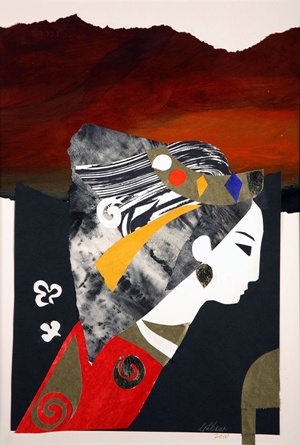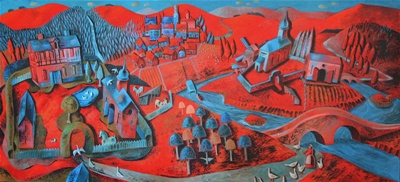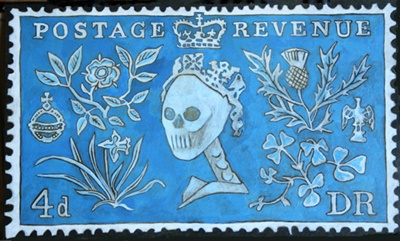09.11.10
Two years ago Y Tabernacl: MOMA Wales in Machynlleth asked me if I would curate an exhibition for them on a subject of my choice. The idea that came to mind was art for children. The resulting exhibition, Art for Children, is at MOMA Wales until 8 January 2011 .
If they are lucky enough to have art around them growing up, children’s attachment to it can last a lifetime. The MOMA Wales exhibition is of works specially chosen to be enjoyed by children. It includes some works that are available to buy and others that have been loaned by people who grew up with them over the last 10, 20 or even 60 years.
I was fortunate to grow up in a house full of pictures and sculptures – my parents were both artists and many of their friends were artists – and I know that this experience stimulated my lifelong interest in the visual. But the experience that brought the question of art for children to the front of my mind was curating another exhibition at the National Museum of Wales in 2004, on the art collecting of John Gibbs and his family between 1945 and 1996. The exhibition and the accompanying book were called An Art-Accustomed Eye because a motivation behind John Gibbs’s collecting (emphasised by his background as an educational psychologist), was to help people in and beyond his family discover the enjoyment, stimulation and comfort of art.
As a father and grandfather, John went beyond choosing work for the drawing room or child’s bedroom to giving children an opportunity to enter a gallery and choose something themselves. He found that, if encouraged to look hard, even very young children make extraordinarily insightful choices. An account by his grandson, Joseph, of being taken by John to choose art was so touching and wise that I included it in the book, and it was republished in Planet.
There’s nothing “educational” in the exhibition – I didn’t want to give children what they ought to like. It is quite a personal selection, based on my own and others’ experience of the art that most drew us in as children. Its qualities include fascinating detail, landscapes to enter in the imagination, objects from a child’s world, storytelling, humour, animals or characters, and vivid, expressive imagery. The exhibition explores some of these ideas through works loaned by adults who had them as children, items from the permanent collection of MOMA Wales, a group of eight School Prints of the 1940s (by Felix Kelly, Kenneth Rowntree, Julian Trevelyan and Picasso among others), and prints, paintings and ceramics by selected contemporary artists, most of them from Wales.
Art that children love is not necessarily created especially for them, but it is nearly always by artists who connect in their mind’s eye back to their own childhoods. The contemporary artists I approached were ones who I feel have this quality. Work has been contributed to the show by Glenys Cour, Keith Bayliss, Clive Hicks-Jenkins, Robert Macdonald, Charles Shearer, Sarah Philpott and Meri Wells. Many of the artists have provided brief accounts of what they were thinking about when preparing work for the show, or about their own childhood memories of responding to art. (The quotations from the artists below all come from their statements for the exhibition.)

Blodeuwedd by Glenys Cour (Photo © Glenys Cour)
There aren’t many children who don’t find animals fascinating, and one section of the exhibition represents this interest. William Brown, who died two years ago, portrayed animals with great vigour and admiration. He may have sensed them as being expressions of different sides of his own personality – he particularly loved to paint big, humorous bears, and he was a bear of a man. His regular creatures were wolves, moose, bats, elephants. In Optimism (Dodo) (1999), the poor, solitary dodo looks out towards the silhouetted ship that brought hunting and extinction to his flightless species. He is optimistic, but the erupting volcano underlines the apocalyptic future, while adding Brown’s characteristic spark of humour. Robert Macdonald grew up on farms in Britain and New Zealand and his father was a vet, so he sees cows, sheep, dogs and horses alongside people as part of the farming life. Meri Wells’ images of creatures express another side of the appreciation of animals altogether, capturing likenesses of creatures with very human characters and preoccupations. Viewers may think they come from her imagination, but she maintains she knows them personally.
When you are a small child you get really close to things, and you are very familiar with their feel and smell, even their taste. For children, lots of objects take on powerful personalities, which most adults are never aware of in quite the same way. Some artists do capture and convey a child-like appreciation of things. The artist and illustrator Eric Ravilious took great delight in objects, as shown by the dozen motifs on his handkerchief for a child, designed in 1942, a rare example of which has been loaned to the exhibition. Clive Hicks-Jenkins still collects traditional toys like the ones he knew as a boy and likes to show his love of them in paintings. His painting My Dream Farm (2010), done especially for the exhibition, is both an object and a landscape.

My Dream Farm by Clive Hicks-Jenkins (Photo © Clive Hicks-Jenkins)
It is the artist’s idea of a perfect toy farm, made with many wooden pieces, but it is also a world that you can wander into in your imagination – or your dreams. He says:
“There were no paintings on the walls when I was a child, but some of the book illustrations I recall with pleasure were representations of landscapes and towns that I could trace paths through because there was a flattened perspective or an aerial overview. Then my parents gave me the most beautiful toy farm. It was made of wood and included a farmhouse, barn, animal pens, a pond and, more unusually, a windmill with sails that turned. It was spanking new and bright with vivid paint. It didn't look as though it had been made in the UK – there was a feel to it of a German toy, or perhaps Czech. I've never seen anything quite like it since... I've always regretted the loss of that beautiful toy.”
Pictures can be windows to a different world, and sometimes they deserve much closer examination than adults give them. Children are very good at looking closely, because they love all the details in images and follow routes and pathways through them. Richard Eurich’s and John Piper’s pictures in the exhibition were designed particularly for children and contain lots to see. Piper’s Nursery Frieze I and II (1937), was produced by the company he set up in 1936, Contemporary Lithographs, which made interesting prints available cheaply to schools and families – a decade before School Prints. He wanted the pair of prints to join together as a huge panorama of coastal life, with flags, figures, fireworks, boats, bathing-huts, buoys and beaches, passing from day to night to day again. He brought together his love of landscape with abstract shapes, deft marks and collage to create both detail and energy. It is a perfect world for a child to enter into through the mind’s eye.
Some pictures are packed with detail, like Lowry’s image of families at play in Salford or John Nash’s depictions of life in the countryside. Others attract by their distinctive atmosphere, like the cool, ghostly print by Felix Kelly of steamers in a grand port. Sara Philpott’s imagined landscapes are full of pattern and detail, expressing a child’s sense of wonder. Charles Shearer’s show the love he has had since he was a child for the kinds of strange, forgotten places that adults may have no business going to but that draw children like magnets. He says:
“I find myself drawn towards those romantic, windowless, tumbling mansions where only the cracking caw of a rook or raven can be heard about its many chimney stacks. Where once sober clad servants busied themselves about orderly routines, whole trees have grown, and in the master’s chambers gardens of mosses and lichen have formed amongst the rotting debris. As a child you would be equally attracted and repelled by adventure within any such place, but growing up in Orkney you were never far from ruins, be it palace, broch or wartime gun emplacement. This was our playground.”
Definite personalities fascinate children – we have all had favourite aunties, liked strange characters and been drawn to the unusual. This can be difficult to capture in visual art, but some artists have succeeded at conveying characters that children will find interesting. Philippa Robbins has created a whole set of characters especially for this exhibition. They might appear scary at first, but they will make lots of children laugh, and they form a memorable family like you’ve never seen before. She says:
“Dora is a flat, tin Day of the Dead character. She is simply made and there’s something endearing about her despite her being a skeleton. Children are attracted by so many stimuli – from pastel to primary colours, miniature to the grandest scales, and all subject matters, so in deciding how to approach these paintings I drew on things that delighted me as a child. I was often drawn to vulnerable and unusual characters and could invest just about anything vaguely animate – dolls, mummies in the British Museum, animals – with an imagined empathy, a secret connection. As a skeleton there’s something dark about Dora, but if she’s scary, she’s safely scary like Stig of the Dump.”

Long Blue Stamp by Philippa Robbins (Photo © Philippa Robbins)
Where would childhood be without stories? The books produced by the Old Stile Press give the artists an opportunity to make multiple images that trace a story from beginning to end, though they may not follow the action exactly, but build on it and extend it with their own imaginations. Keith Bayliss’s preparatory drawings inspired by the story of the medieval “Children’s Crusade” led to him producing the book White Voices. The exhibition also includes some original illustrations by two of the greatest children’s illustrators – Edward Ardizzone and Kathleen Hale, the creator of Orlando the Marmalade Cat. Glenys Cour has made a series of collages especially for the exhibition, sparked in her imagination by the princesses of the Mabinogion. She says: “I hope they may evoke the magic of the spirit of the Celtic tales – full of golden princesses, knights and wizards wandering in mysterious landscapes and glorious palaces.”
Robert Macdonald brings memories of events into his paintings:
“I was born in 1935, and so the first half of my childhood was dominated by the war. Harvest Moons is about the sense of danger and conflict in the sky which we all felt in those days, but it also reflects a child’s fascination with the colourful insignia of war – the markings in bright red, white and blue, yellow and black which we saw on aircraft and on military vehicles. My grandmother came to see me and took me for a walk one day. We stood under a tree and watched as a thousand British bombers flew overhead, not much above treetop height, their crews looking down at us and their fuselages brightly painted with such insignia, heading towards Cologne.”
Of course, one of the delights of visual art is that it can inspire new stories, and children looking at many of these images will be able to make up stories of their own that match what they see.
I hope adults will be inspired by the MOMA Wales exhibition to bring art into the lives of children – whether sons and daughters, godchildren, nieces and nephews, or the children of friends. Good art comes in many forms. Well-illustrated books can be superb, cheap posters can be wonderful things to have, limited-edition artists’ books and prints are not expensive. Children can even acquire things for themselves – most of the “art” in my own bedroom was free: pictures cut from the Observer Colour Supplement week by week and pasted on my wall. But there is an exciting privilege in growing up with a unique sketch, painting, sculpture or ceramic, which belongs in your life and your’s alone.
I hope the experience of the exhibition will be enjoyed by people of all ages and sizes, and they go away thinking more about how to feed imaginations through art.
Peter Wakelin